|
French Connection: The Barbizon Influence
Exhibited May 15 to July 15, 2007
(Reception Sunday, June 17th, 4-6 pm)
next exhibit all exhibits
A group of French naturalist painters beginning in the 1820s broke from formal traditions of landscape painting and initiated a new style that was to influence the direction of landscape art into the 20th century. The school eventually took its name from the village of Barbizon on the outskirts of the Forest of Fontainebleau where they often painted. Barbizon artists are considered the first "plein-aire" painters, painting directly on site rather than completing their scenes in studios from sketches. These new landscape painters expressed fascination with changing seasons, changing times of day and the effects of transient light on the landscape. Barbizon artists had no uniform style but were identified because of their commitment to portraying the details of the natural world rather than the formal and romanticized images of their predecssors. Following Millet, they often included working peasants in their landscapes, which was antithetical to the prevailing approaches to fine art.
Figure in a Dark Forest, c.1870
oil on canvas 20x26, 28x34 Framed
By the mid-19th century there was a large and loosely organized movement with hundreds of notable adherents. Chief among the French Barbizon painters were Camille Corot, Francois Millet, Theodore Rousseau, and Charles Daubigny. American painters much influenced by the Barbizon School were George Inness, Homer Dodge Martin, Alexander Wyant, and William Morris Hunt .
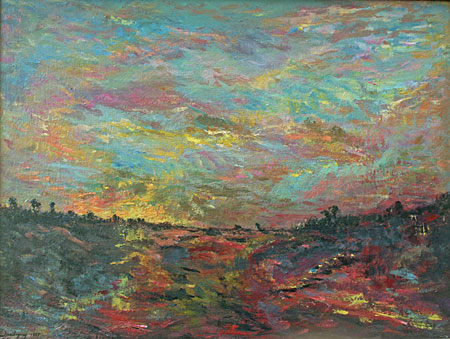
Coucher de Soleil
Charles-Francois Daubigny (1817 - 1878)
The first of the great plein aire painters and a key figure associated with the Barbizon School, Daubigny was highly influential in connecting the work of the landscape masters of his own generation with the impressionists and their contemporaries who followed them. Daubigny worked directly from nature in order to capture the everly changing light that illuminated his favorite subjects. This beautifuly rich and sumptuous impressionist landscape depicting a wonderful sunset was probably painted alla prima from his floating studio on the River Oise. It is signed and dated lower left: 'Daubigny 1865'. It is framed in an ornate gilded period frame.
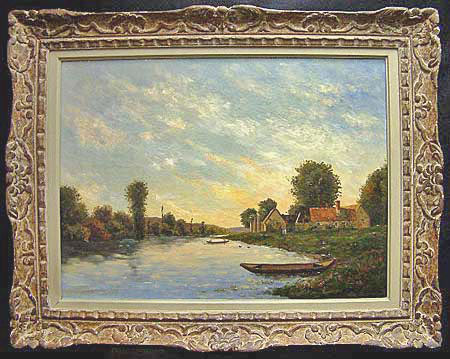
Au bord de la riviere
Jacques-Henri Delpy (1877-1957)
Jacques-Henri Delpy was the talented son of the French artist Hippolyte-Camille Delpy, a student of Daubigny. Like his father he is known for his detailed paintings of landscapes, villages, rivers, lakes, fishermen, and boats. Here he depicts the exquisite evening light of a sky with wisps of clouds, reflected in the River Oise and illuminating the riverside farm.
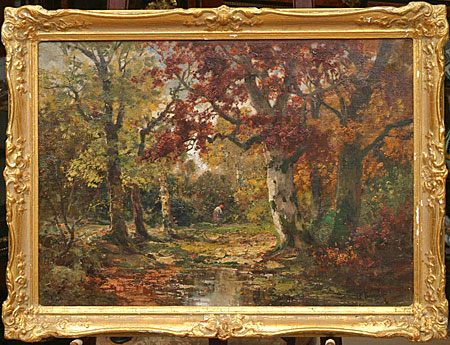
Foret d'Autumne
P. Dumont
AUTUMN FOREST ca 1930
oil on canvas 19 x 25
Period Gold Frame; 24 x 30
signed lower right "P. Dumont"
Condition: excellent with no restoration
This post-Barbizon era painting is reminiscent of the extraordinary forest interiors painted on site in the forest of Fontainebleau by the first generation of Barbizon painters, particularly Rousseau and his pupil Diaz de la Pena. Compare it with the Barizon Forest masterpiece by Diaz de la Pena below:
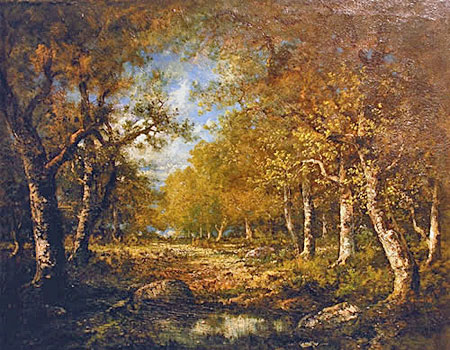
Barbizon Forest
Narcisse Diaz de la Pena
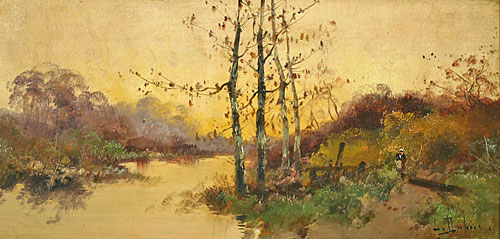
"Autumn River Landscape"
Eugène Galien-Laloue (1854-1941)
Oil on Panel, 7 x 14, Framed 12 x 20
signed lr: L.Dupuy
Born in Paris in December of 1854, Eugene Galien-Laloue is recognized as one of the top masters of French impressionist street scenes and landscapes. Beginning in 1877 he was student of Charles Laloue, a long-time member of the Artistes Francais, a prestigious French art association. Galien-Laloue became well known at the turn of the century for capturing the bustling ambiance of Paris, but he also liked to paint tranquil country scenes in a manner reminiscent of the earlier Barbizon masters. This work shows Galien-Laloue unique talent for combining elements from both schools in a single painting.
During the early part of his career as an artist Galien-Laloue took on several pseudonyms because of an exclusive contract with a major gallery. These pseudonyms included E.Galiany L. Dupuy, J. Lievin, Lenoir, Michel.. all of which are listed in the E. Benezit Dictionnaire des Peintres.
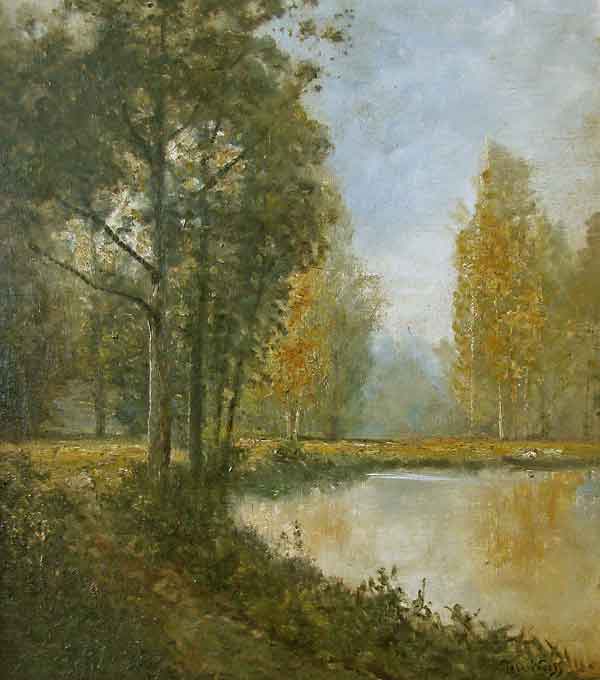
Jose Weiss (1859-1919)
Untitled Barbizon Study (oil on Board, 22" x 26")
Gilded Antique Wood Frame, 27" x 31"
Jose Weiss was born in Paris in 1859 and emigrated to England in 1893. He ived at Houghton, near Arundel, from 1897 and painted the Sussex landscape. His unusual hobby was that he was one of the nations first glider pilots. Weis exhibited Barbizon style landscapes such as this forested pond at the RA, RBA and the Paris Salon.
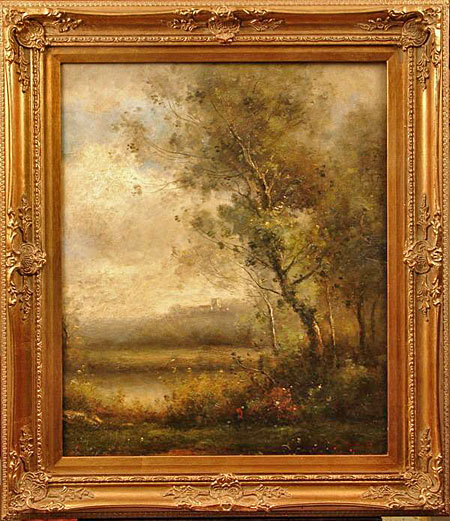
Homage to Corot
G. Wildy (French 20 century)
oil on canvas 20 x 26 in/ 28x34 Framed
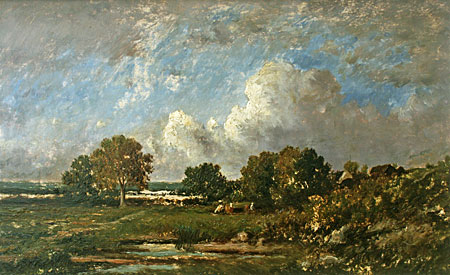
19th century Barbizon landscape
oil on board 10x16
Although unsigned, this painting is clearly the work of a talented late 19th century artist working in the Barbizon style of Rousseau or Daubigny. In the center of a lush, wet landscape, are grazing cattle with a lake in the background and above it all a wonderful sky full of towering clouds.
Compare this image with similar paintings by Daubigny or Rousseau, below.
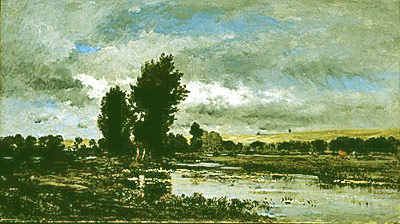
Charles-Francois Daubigny
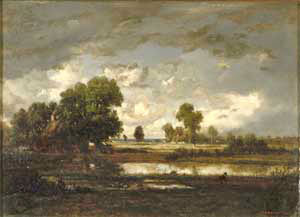
Theodore Rousseau
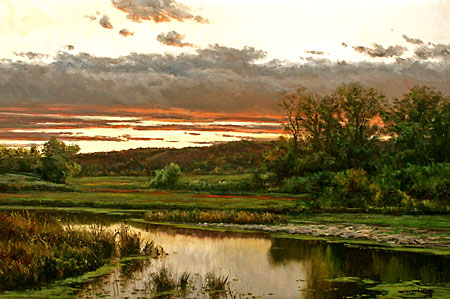
After the Storm
Joan Colomer
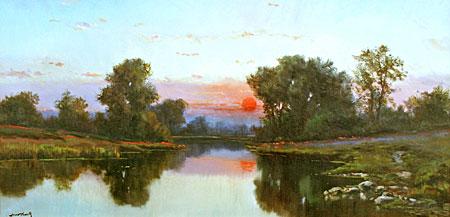
Crimson Sunset
Joan Colomer was born in 1965 in the Catalonia region near Olot, Spain, at San Feliu de Pallerols. In this city, some 125 years ago, the painter Joaquim Vayreda initiated the Olotina Landscape School. This assured that young Joan was raised amid a rich artistic heritage of his family and the inspirational landscape tradition immediately surrounding him. Colomer first learned to paint alongside his two brothers under the instruction of their father. Shaped by the pastoral countryside of deep forests and roving hills typical to the Olotina Landscape School a contemporary to the Barbizon school, Colomer is most known for his brilliant vistas capturing complex nuances of light. After extensive traveles, in 1990, he settled in Madrid to attend the School of Beaux Arts, and began exhibiting his works in Barcelona and Madrid, and now Colomer's paintings are shown in galleries around the world.
American Painters in the Barbizon Mood
Initially influenced by French Barbizon painting by way of American exponents George Inness (1825-1894), William Morris Hunt (1824-1879), American painters in this school tended to use a neutral palette of predominantly cool colors: green, blue, mauve, violet, and a delicate range of intervening grays, carefully modulated to produce a dominant tone. Preferred subjects were scenes of dawn or dusk, rising mist and moonlight in which the enveloping atmosphere is evocative of poetic and meditative states.
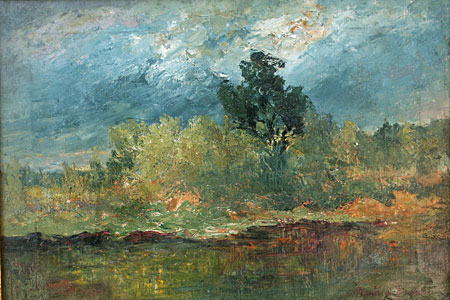
|
Study of the Outdoors (oil on canvas, 13.5" x 19.5")
Maria A' Becket (1840-1904)
Maria A' Becket was a member of the first generation of American Barbizon painters and is cited in many American art references of her era. She was born in 1840 in Portland, Maine, Daughter of Charles Beckett, a Maine Landscape and genre painter. In 1865 she studied with Homer Dodge Martin and later with William Morris Hunt in Boston. She was influenced by the Barbizon painters at Pont Aven and painted with the famous French painter Charles-Francois Daubigny during a trip to France. Shortly afterwords she painted scenes like the one above on excursions into the White Mountains. Her palette is strong dense, deep with greens, burnt sienna, deep blues, and a mature loose brushstroke that one seldom acquires in a short artistic career displaying her natural talent as well as the experience gained by studying with the masters of early impressionism. Though her Barbizon influence is often stressed, this work reveals strong elements of Tonalism. She exhibited at the Boston Art Club in 1875, the National Gallery in 1883 and 1888, and at the Pennsylvania Academy of Fine Arts from 1880 to 1884 and the New York’s Women’s Club to name just a few.
This work, titled verso “Study of the Outdoors”, is an exquisite oil on canvas that exudes her brilliant tonalist eye with wonderful impasto effects creating reflections and light play. The technique of glazing, the layering of thin layers of pigment suspended in oil or varnish, came to play an important part in the Tonalist repertoire of effects. Light penetrating these thin washes of color to an undercoat of more solid color was reflected back to the surface, producing a jewel-like quality of scintillating, bewitching hues. The smoky quality or sfumato, also achieved by such methods, imparted a vibrancy of contour and blurring of forms that came to characterize many American tonalist landscapes.
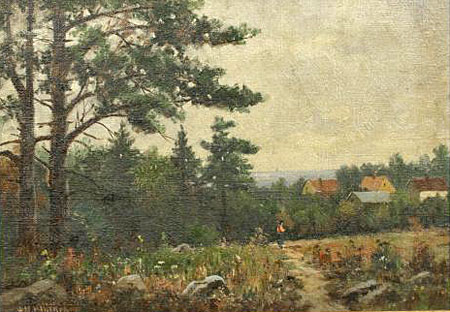
William Henry Hilliard (American, 1836-1905)
Landscape with Houses (oil on canvas, 11 3/4" x 16 1/2")
In a frame measuring 15 1/2" x 20 1/4".
William Henry Hilliard, born in Auburn, New York, in 1836, was a painter of realistic, tonal landscapes related to the Hudson River School. He studied in New York City prior to painting in England and Scotland, then studying with the Barbizon landscape painter, Lambinet in Paris, France. Until 1878, he was based in New York City, but moved to Boston, Massachusetts. He was known for his New England landscapes, views of Maine, the Atlantic Coast, White Mountains and Franconia Mountains. He exhibited at the National Academy of Design, New York City, from 1876 to 1888, and the Brooklyn Art Association, in New York, as well as many other national venues, winning prizes and medals.
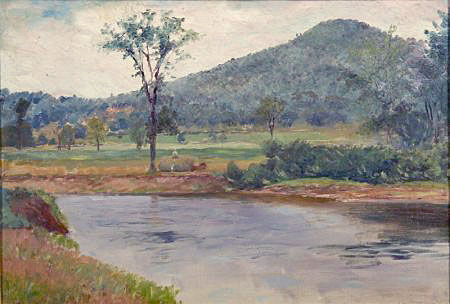
John Joseph Enneking (1841-1916)
Milton, Blue Hills
Signed and dated "Enneking 93" l.l.,
catalog raissonee label from Pierce Galleries
14 x20 in Antique Frame 19 x 26
Known for Barbizon and Impressionist styles, Enneking was one of the most popular landscape painters of New England and one of its most successful financially. Enneking held membership at the Boston Art Club, Connecticut Academy of Fine Arts and the Salmagundi Club. His works are part of the collections of the Boston Museum of Art and the Worcester Art Museum, Farnsworth Art Museum,etc. In 1868 he went to Boston, where he studied lithography and began to paint landscapes. The catalyst for his success came while studying in France with Leon Bonnat and Charles Francois Daubigny during the 1870s on an extended stay, and when he is said to have painted with Monet. Enneking returned to Boston in 1876, and in 1878, his first solo in Boston sealed his reputation. Beginning in the early 1880s he spent summers in North Newry, ME. and also painted frequently in the White Mountains.
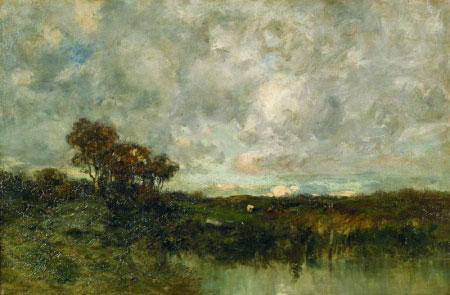
Charles P. Gruppe, American. 1860-1940
Cattle Grazing
Oil on canvas, 24 x 36 in. in excellent period frame
Charles Gruppe was born in Canada, and moved to New York State was he was ten. Primarily a tonalist landscape and marine painter, Charles Gruppe was largely self-taught although he spent time studying in Europe, eventually settling in Holland for a time where he developed his skill at subtle coloration and careful draftsmanship. His landscapes, like the one above, reflect the influence of the Barbizon school and the earlier Dutch landscape tradition of the Hague school. Charles Gruppe returned to America becoming a painter and well as a dealer. His son, Emile, who became a famous painter himself, was born in 1896. In 1925, after seeing a number of Rockport and Gloucester harborscenes at an exhibition in New York, father and son traveled to the Cape Ann area of Massachusetts. They fell in love with the location, set up studios and painted there for the rest of their lives. The Gruppe family studio remains there to this day.
Charles Gruppe exhibited at the National Academy of Design (NAD), the Pennsylvania Academy of the Fine Arts (PAFA), the Boston Art Club, and also in Paris where he won a gold medal at the Rouen Exhibition. His paintings are included in the collections of the National Gallery, the Brooklyn Museum of Art, the National Arts Club, the National Gallery in Canada, the Queen of Holland Collection, and in the Art Museum in Rouen, France.
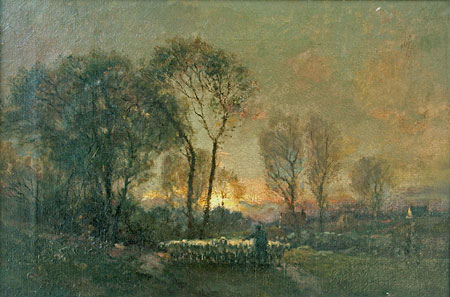
Shepherd's Lane (Oil on canvas, 12" x 16")
Charles Appel (1857-1928)
Born in Brooklyn, New York, Charles Appel is known for romantic landscapes in Barbizon and Impressionistic styles. He was a pupil of Francis Luis Mora and William Merritt Chase at the New York School of Art and of Frank Vincent DuMond at The Art Students League. As is evident in the painting here, the major influence on his career, however, was George Inness. Most of his life was spent in East Orange, New Jersey from where he was active in New York art circles and elected a member of the Salmagundi Club in 1906.
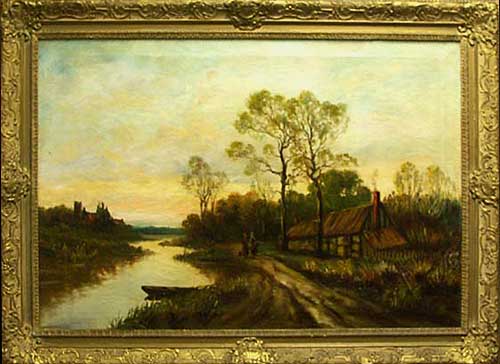
"Riverside Farm" by Howard Leeds, American, c.1918
Howard Leeds was an early 20th century American artist who was influenced by the Barbizon school. This painting (ca. 1918) is a large impressionist oil of a river meandering through the French countryside, similar in subject and style to the classic works of Daubigny who often painted river scenes like this in evening light from a floating studio.
Contemporary Works in the Barbizon Manner
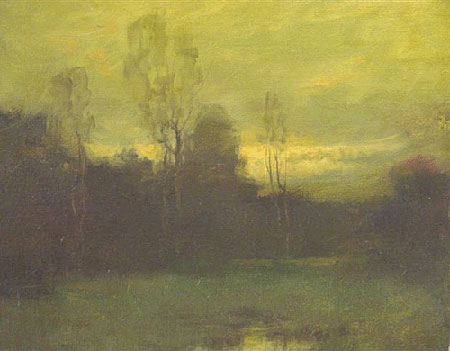
Marsh at Dusk (oil on linen, 20" x 24")
Dennis Sheehan
Dennis Sheehan, born in Boston in 1950, is a member of the Guild of Boston Artists, and currently lives and works in the New Hampshire countryside. His work is in major public and private collections, including the White House. Sheehan paints in the Barbizon mode with remarkable authority and faithful adherence to his 19th century precursors. In the tradition of Inness and American Tonalist painters, Sheehan creates landscapes of mood, affected by nature's changing seasons. Mystery, dream, memory, and imagination are often espoused in their haunting, broadly painted canvases of dusk and moonlight.
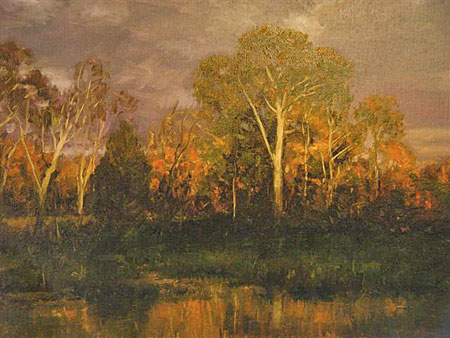
October Gold (oil on canvas, 24" x 36")
Dennis Sheehan
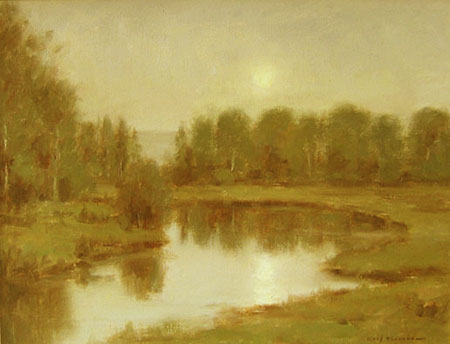
Summer Moon (14x18 oil on canvas)
Karl Thomas
Widely acclaimed for his plein air compositions of the Grand Canyon of Arizona, The Grand Tetons of Wyoming and Wasatch Mountains near his Utah home, Karl Thomas acknowledges the influences of Inness, Sargent, Bierstadt and Moran on what he describes as his own style of "realistic impressionism." Early inspiration at his father's easel led to art studies at Brigham Young University, where he graduated in 1982, and the Los Angeles Art Center. Karl Thomas is represented by major galleries from California to New York. He was featured in the January/February 1990 issue of Art of the West and was selected in the top 100 artists in the Arts for the parks Exhibition in 1995.
Marsh at Sunset (oil on canvas, 8" x 16")
William McLane, Jr.
The works of William McLane, Jr. are highly collectible and hang in galleries and homes throughout the United States and abroad. His artwork is particularly well known on the East Coast – especially on the islands of Nantucket and Martha's Vineyard and the coast of Maine. He is a member of the Artist's Association of Nantucket. He is a versatile painter whose work varies from abstract to impressionism always with an effective vibrant use of color and excellent composition.
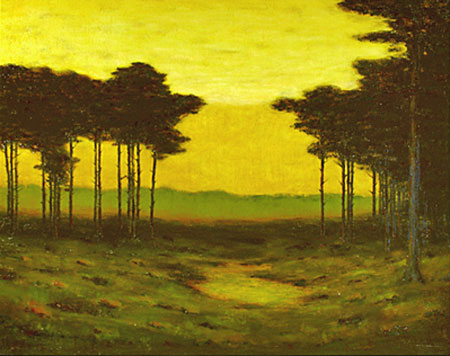
The Pines (o/c 24 x 30)
Michael Fratrich
Michael Fratrich's eye for rural New England scenes is translated by brushstroke into two distinct styles: American Realism and Barbizon Tonalism. His first love is for detailed renderings of everyday scenes, but though he creates paintings derived from real places, they are not intended to be simply representational. In his Tonalist work, such as "The Pines", Michael explores a more expressive style of landscape art, relying on soft-edged broadly painted tonalities in the manner of Eaton to communicate a serene evening mood.
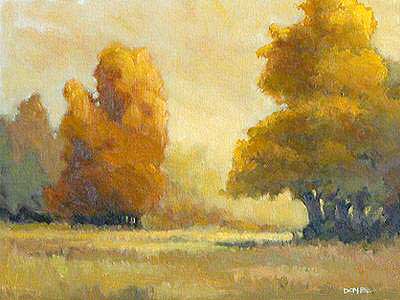
November Morning (oil on canvas, 11"x14")
Don Bishop
Don Bishop is rapidly emerging as one of the most accomplished tonalist painters in the Pacific Northwest where he divides his time between plein air and studio work. Most of his pieces are painted alla prima using different color combinations according to the season and light. His roots are firmly planted in the early Californian impressionism because of the outstanding patterns of color and atmosphere associated with this school. Don has won several awards at recent shows including a blue ribbon at the 2003 Lake Oswego Art Festival, and has patrons throughout the US include Senator John Edwards and his wife, Elizabeth, of North Carolina.
For prices of these and other works in this exhibition please see the "paintings and artists" section of the site. Better still, stop by and visit the gallery during the spring or for the opening wine and cheese reception on Sunday, June 17th, 4-6 pm
See the calendar for future exhibitions.
|

|
|

